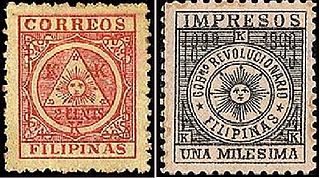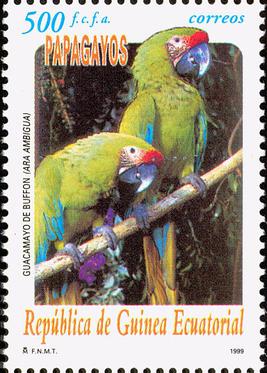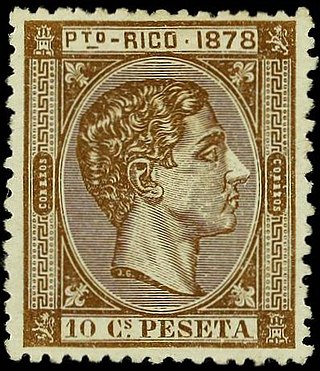This is a survey of the postage stamps and postal history of Afghanistan.

The Prince Consort Essay was a surface printed printer's sample stamp created in 1851 as an example of the surface printed stamps that Henry Archer proposed to print and perforate under contract with the British government at a lower price than the current printing firm of Perkins Bacon. The Prince Consort stamps were provided by the artist Robert Edward Branston, from an engraving executed by Samuel William Reynolds.
Spanish postal codes were introduced on 1 July 1984, when the Sociedad Estatal de Correos y Telégrafos introduced automated mail sorting. They consist of five numerical digits, where the first two digits, ranging 01 to 52, correspond either to one of the 50 provinces of Spain or to one of the two autonomous cities on the African coast.

Sociedad Estatal de Correos y Telégrafos, S.A., trading as Correos, is a state-owned company responsible for providing postal service in Spain and, due to bilateral agreements, it has responsibility for mail services in Andorra alongside the French company La Poste.

The Mexican postal system has its roots in the Aztec system of messengers which the Spanish adopted after the Conquest. A postal service was established in 1580, mainly to communicate between the viceroyalty of New Spain with the motherland Spain. During the 18th century, Spain established a formal postal system with regular routes. In 1856, Mexico issued its first adhesive postage stamps, with "district overprints", a unique feature among postal systems worldwide, employed to protect from theft of postage stamps.

Argentine postage stamps were first issued in 1858 by the Argentine Confederation and nationally by the new Republic's National Postal Service in 1862. Due to the continuing civil wars, a number of provinces and territories, particularly in the then-remote far north and far south, continued to issue their own postage brands and stamps for some time, afterwards; some of these issues have since become collectors' items.

Correos de México, formerly named Servicio Postal Mexicano, is the national postal service of Mexico. It has been active for over 100 years, and its system has roots going back to 1580.

Ferdinand II was King of Aragon from 1479 until his death in 1516. As the husband of Queen Isabella I of Castile, he was also King of Castile from 1475 to 1504. He reigned jointly with Isabella over a dynastically unified Spain; together they are known as the Catholic Monarchs. Ferdinand is considered the de facto first king of Spain, and was described as such during his reign, even though, legally, Castile and Aragon remained two separate kingdoms until they were formally united by the Nueva Planta decrees issued between 1707 and 1716.
Between 1851 and 1860, the Grand Duchy of Tuscany, an independent Italian state until 1859 when it joined the United Provinces of Central Italy, produced two postage stamp issues which are among the most prized classic stamp issues of the world, and include the most valuable Italian stamp.

Isabella I, also called Isabella the Catholic, was Queen of Castile and León from 1474 until her death in 1504. She was also Queen of Aragon from 1479 until her death as the wife of King Ferdinand II. Reigning together over a dynastically unified Spain, Isabella and Ferdinand are known as the Catholic Monarchs.

Colombia is a country in north-western South America. Colombia is bordered by Venezuela, Brazil, Ecuador, Peru, Panama and the Caribbean Sea and the Pacific Ocean. With a population of over 45 million people, Colombia has the second largest population in South America, after Brazil. The capital is Bogotá.

Correos de Costa Rica is the national postal service of Costa Rica.

El Salvador became independent from Spain in 1821. It has produced its own stamps since 1867.

This is a survey of the postage stamps and postal history of the Philippines.

This is a survey of the postage stamps and postal history of Uruguay.

This is a survey of the postage stamps and postal history of Equatorial Guinea, formerly known as Spanish Guinea.

The postal history of Puerto Rico began around 1518, at least for official mail, when Spain adopted general postal regulations; although the first documentation of Spanish postal regulations specific to the Caribbean was 1794. The first postage stamps were issued 168 years ago for Puerto Rico and Cuba in 1856. Postage stamps just for Puerto Rico followed, and later postal cards and telegraph stamps were issued. United States postal administration began in 1899 and the last stamps specifically for Puerto Rico were issued in 1900. They were superseded by U.S. stamps, which are still used today on the island as it remains a territory serviced by the United States Postal Service (USPS).

The Royal Mint of Spain is the national mint of Spain. The FNMT-RCM is a public corporation that is attached to the Ministry of Economy.

The Official Post Service of the Argentine Republic is the state-owned company that covers the postal service in Argentina. The company is a S.A. under the country's Office of the Cabinet Chief.
This is a survey of the postage stamps and postal history of Holstein, Schleswig-Holstein, Schleswig and incidentally Lauenberg. Separate stamps were issued for Holstein (1850), Schleswig (1864-1867), Holstein (1864-1866), Schleswig-Holstein (1865) and Schleswig (1920).
















